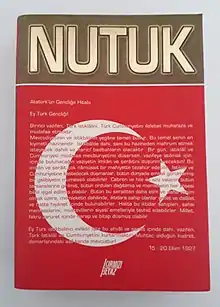Nutuk
Nutuk (Modern Turkish: Söylev; The Speech) was a speech delivered by Mustafa Kemal Atatürk from 15 to 20 October 1927, at the second congress of Cumhuriyet Halk Partisi. The speech covered the events between the start of the Turkish War of Independence on 19 May 1919, and the foundation of the Republic of Turkey, in 1923. It took thirty-six hours (on a 6 day span) to be read by Atatürk, and became a foundation of Kemalist historiography.


Background (Calligraphy): حاكميت ملتكدر Hakimiyet Milletindir means "Sovereignty Belongs to the People"
Content
About two-thirds of this speech consists of a series of heavy criticism against the following individuals: Kazım Kara Bekir Pasha, Rauf Bey (Orbay), Refet Pasha (Bele), Mersinli Cemal Pasha (Mersinli), Nureddin Pasha, Kara Vasıf Bey (Karakol), Zeki Bey (Kadirbeyoğlu), Celaleddin Arif Bey, Cafer Tayyar Pasha (Eğilmez), Ali Ihsan Pasha (Sâbis), Bekir Sami Bey (Kunduh), Rıza Nur Bey, Edhem Bey and his brothers, Selahaddin Bey (Köseoğlu), Hussein Avni Bey (Ulaş), Ali Rıza Pasha, Şerif Pasha, Ahmet Izzet Pasha (Furgaç), and Çürüksulu Mahmud Pasha.
Analysis
Turkish historian Fatma Müge Göçek notes that the speech "officially adopted as the official Turkish national narrative and became sacralized by the state". Göçek states that, because the law criminalizes insulting Atatürk, Turkish historians have been unable to analyze the speech critically. Göçek focuses on what remains unsaid in the speech: "It is evident that the text commences the birth of the Turkish nation with 1919, removing in the process the demise of the Armenians in 1915 through state violence to the realm of Republican prehistory."[1]
Historian Marc David Baer states:
The main themes of the speech—and of the official discourse on the Armenian genocide—are silence, denial of the genocide, general amnesia about past violence (unless presenting Turks as the real victims), identifying with the perpetrators, never questioning the great prophetic and infallible leader (Atatürk), and promoting the racial purification of the land in the face of a life-or-death Darwinian struggle with minorities.[2]
References
- Göçek, Fatma Müge (2011). "Reading Genocide: Turkish Historiography on 1915". In Suny, Ronald Grigor; Göçek, Fatma Müge; Naimark, Norman M. (eds.). A Question of Genocide: Armenians and Turks at the End of the Ottoman Empire. Oxford University Press. pp. 42–52. ISBN 978-0-19-979276-4.
- Baer, Marc D. (2020). Sultanic Saviors and Tolerant Turks: Writing Ottoman Jewish History, Denying the Armenian Genocide. Indiana University Press. p. 82. ISBN 978-0-253-04542-3.
Further reading
- Ulgen, Fatma (2010). "Reading Mustafa Kemal Atatürk on the Armenian genocide of 1915". Patterns of Prejudice. 44 (4): 369–391. doi:10.1080/0031322X.2010.510719.
External links
- Complete text in Ottoman Turkish
- Ataturk Research Center, Ankara, Turkey
- Atatürk Society of Canada translation
